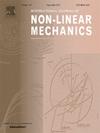Data-driven modeling of bolted joints by Iwan dictionary and Laplace prior-enhanced sparse Bayesian learning
IF 3.2
3区 工程技术
Q2 MECHANICS
International Journal of Non-Linear Mechanics
Pub Date : 2025-04-05
DOI:10.1016/j.ijnonlinmec.2025.105099
引用次数: 0
Abstract
Numerous constitutive and phenomenological models have been developed in an attempt to adequately represent the frictional hysteresis of bolted joints. However, those models do not comprehensively account for parameters of interest, such as multiscale asperities, variable normal forces, and thermal environments, limiting their applicability to certain conditions. This paper develops a data-driven modeling approach to calibrate bolted joints, enabling the simulation of their asymmetric hysteresis arising from parameters of interest. To this end, an Iwan dictionary is developed from the superposition principle of the Iwan bolted joint model, and reconstructed completely by the macro-slip physical information and the Duhem hysteresis operator. Subsequently, a Laplace prior-enhanced sparse Bayesian learning method is employed to sparsely identify Iwan dictionary’s coefficients and quantify their associated uncertainties, by minimizing the residual between measured and simulated forces. Within this Bayesian learning method, coefficients are estimated initially by an overdetermined linear formulation which is constructed using the Iwan dictionary and the derivatives of measured forces, and then are updated by implementing the sensitivity analysis to the data-driven model. Numerical and experimental studies demonstrate that the coefficients of the Iwan dictionary are identified sparsely, resulting in a data-driven model that is both concise and interpretable. The resulting model activates only a few of the most relevant basis functions of the Iwan dictionary, effectively capturing the asymmetric hysteresis of bolted joints subjected to variable torsional, thermal, and tensile conditions.

基于Iwan字典和拉普拉斯先验增强稀疏贝叶斯学习的螺栓连接数据驱动建模
许多本构和现象学模型已经被开发出来,试图充分代表螺栓连接的摩擦滞后。然而,这些模型没有全面考虑相关参数,如多尺度岩石、变法向力和热环境,限制了它们在某些条件下的适用性。本文开发了一种数据驱动的建模方法来校准螺栓连接,从而能够模拟由感兴趣的参数引起的非对称迟滞。为此,从Iwan螺栓连接模型的叠加原理出发,建立了Iwan字典,并利用宏观滑移物理信息和Duhem迟滞算子对Iwan字典进行了完全重构。随后,采用拉普拉斯先验增强稀疏贝叶斯学习方法稀疏识别Iwan字典的系数,并通过最小化测量力与模拟力之间的残差来量化其相关的不确定性。在这种贝叶斯学习方法中,系数最初是通过使用Iwan字典和测量力的导数构建的超确定线性公式来估计的,然后通过对数据驱动模型进行灵敏度分析来更新。数值和实验研究表明,Iwan字典的系数被稀疏地识别,从而产生一个既简洁又可解释的数据驱动模型。由此产生的模型只激活了Iwan字典中几个最相关的基函数,有效地捕获了螺栓连接在可变扭转、热和拉伸条件下的不对称迟滞。
本文章由计算机程序翻译,如有差异,请以英文原文为准。
求助全文
约1分钟内获得全文
求助全文
来源期刊
CiteScore
5.50
自引率
9.40%
发文量
192
审稿时长
67 days
期刊介绍:
The International Journal of Non-Linear Mechanics provides a specific medium for dissemination of high-quality research results in the various areas of theoretical, applied, and experimental mechanics of solids, fluids, structures, and systems where the phenomena are inherently non-linear.
The journal brings together original results in non-linear problems in elasticity, plasticity, dynamics, vibrations, wave-propagation, rheology, fluid-structure interaction systems, stability, biomechanics, micro- and nano-structures, materials, metamaterials, and in other diverse areas.
Papers may be analytical, computational or experimental in nature. Treatments of non-linear differential equations wherein solutions and properties of solutions are emphasized but physical aspects are not adequately relevant, will not be considered for possible publication. Both deterministic and stochastic approaches are fostered. Contributions pertaining to both established and emerging fields are encouraged.

 求助内容:
求助内容: 应助结果提醒方式:
应助结果提醒方式:


